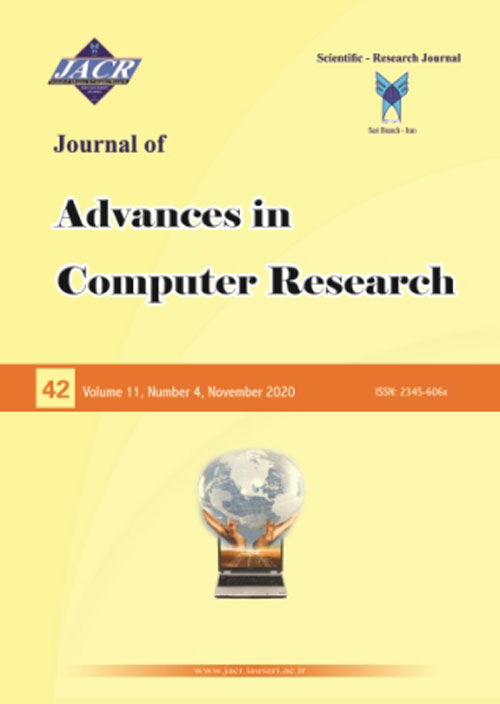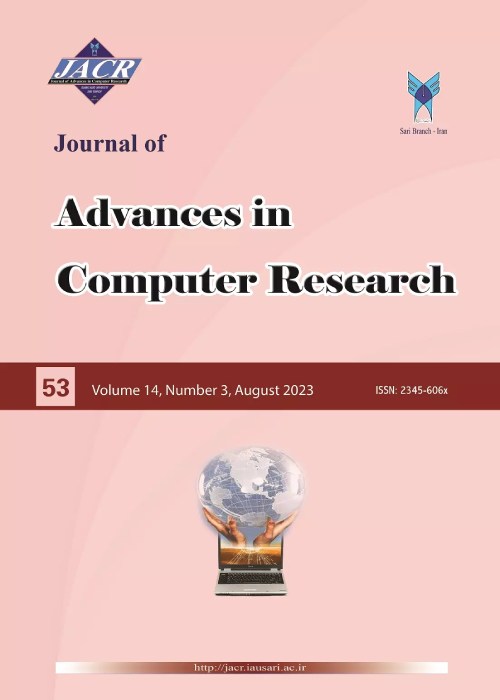فهرست مطالب

Journal of Advances in Computer Research
Volume:11 Issue: 4, Autumn 2020
- تاریخ انتشار: 1399/12/06
- تعداد عناوین: 8
-
Pages 1-22Data clustering is an ideal way of working with a huge amount of data and looking for a structure in the dataset. In other words, clustering is the classification of the same data; the similarity among the data in a cluster is maximum and the similarity among the data in the different clusters is minimal. The innovation of this paper is a clustering method based on the Crow Search Algorithm (CSA) and Opposition-based Learning (OBL). The CSA is one of the meat-heuristic algorithms that is difficult at the exploration and exploitation stage, and thus, the clustering problem is susceptible to initialization for centrality of the clusters. In the proposed model, the crows change their position based on the OBL method. The position of the crows is updated using OBL to find the best position for the cluster. To evaluate the performance of the proposed model, the experiments were performed on 8 datasets from the UCI repository and compared with seven different clustering algorithms. The results show that the proposed model is more accurate, more efficient, and more robust than other clustering algorithms. Also, the convergence of the proposed model is better than other algorithms.Keywords: Data clustering, Crow Search Algorithm, Opposition-based learning, centrality
-
Pages 23-37Text coherence evaluation becomes a vital and lovely task in Natural Language Processing subfields, such as text summarization, question answering, text generation and machine translation. Existing methods like entity-based and graph-based models are engaging with nouns and noun phrases change role in sequential sentences within short part of a text. They even have limitations in global coherence evaluation, especially in long and narrative documents. This paper presents a new and simplified method for evaluating local and global text coherence. The proposed method focuses on entity grid method and employs two graph-based and entropy-based approaches to overcome its challenges and shortcomings. Applying statistical approaches, the presented method studies how to incorporate other entity properties into short and long stories to assess both local and global coherence, simultaneously. Results indicate that the proposed method is superior to other algorithms in terms of performance, accuracy in long documents with a high number of sentences.Keywords: Local coherence, Global coherence, Graph-based coherence, Entity-based coherence, Entropy-based coherence
-
Pages 39-55Recently by developing the technology, the number of network-based servicesis increasing, and sensitive information of users is shared through the Internet.Accordingly, large-scale malicious attacks on computer networks could causesevere disruption to network services so cybersecurity turns to a major concern fornetworks. An intrusion detection system (IDS) could be considered as anappropriate solution to address the cybersecurity. Despite the applying differentmachine learning methods by researchers, low accuracy and high False AlarmRate are still critical issues for IDS. In this paper, we propose a new approach forimproving the accuracy and performance of intrusion detection. The proposedapproach utilizes a clustering-based method for sampling the records, as well asan ensembling strategy for final decision on the class of each sample. For reducingthe process time, K-means clustering is done on the samples and a fraction of eachcluster is chosen. On the other hand, incorporating three classifiers includingDecision Tree (DT), K-Nearest-Neighbor (KNN) and Deep Learning in theensembling process results to an improved level of precision and confidence. Themodel is tested by different kinds of feature selection methods. The introducedframework was evaluated on NSL-KDD dataset. The experimental results yieldedan improvement in accuracy in comparison with other modelsKeywords: Intrusion Detection System, Ensemble Classifier, Clustering, Decision tree, KNearest-Neighbor, deep learning
-
Pages 57-72Over the past two decades, PC speeds have increased from a few instructions per second to several million instructions per second. The tremendous speed of today's networks as well as the increasing need for high-performance systems has made researchers interested in parallel and distributed computing. The rapid growth of distributed systems has led to a variety of problems. Task allocation is a key process for distributed systems to achieve effective system efficiency, which, except for a few cases, is an NP-complete problem. Finding an effective and efficient method for this problem is still sought despite various methods used in studies. Experiments and the results of previous research have shown that NP problems are better solved by exploratory methods than other methods. This study used a parallel genetic algorithm (PGA) to find a solution for proper task allocation to processors in a distributed system. The task allocation policy, obtained using PGA, is much faster than traditional genetic algorithms. The results showed that the proposed algorithm can provide optimal or near-optimal allocations for problems of different sizes. The proposed method also solved large- and medium-sized problems much faster than traditional genetic algorithms and with super linear speedup.Keywords: Distributed System, Task Allocation, Parallel Genetic Algorithm, Static Task Allocation
-
Pages 73-93Before the beginning of the software development project that is based on contract between software user and developer company, the user company provides the RFP including project domain current situations and constraints, and all conditions such as desired initial system requirements specification as well as requesting documents of developer companies capabilities to ask the developer companies for their proposals to fulfill the requirements and competition with each other. This paper renders an evaluation model of proposals including non-functional requirements (NFRs). It is very important, mainly focusing on the NFRs since the system architecture and quality greatly depend on the NFRs. Within this framework, the NFRs existed in the RFP are weighed and are traced in the proposals cause evaluating respected quality attributes coverage and satisfaction level. The model helps the user company and its consultants compare the proposals and choose qualitative desired proposal. As a case study, 6 telecommunication projects RFPs were evaluated by the proposed model. As a result, we have confirmed that the model can forecast the software quality in practical environments and indicate the effect of each quality attribute coverage and satisfaction level for agreement between software user and developer company to trading price and quality offKeywords: Request for Proposal (RFP), Non-Functional Requirement (NFR), Requirement Evaluation, Quality Attributes Evaluation, Evaluation Model
-
Pages 95-106As markets are becoming competitive and changing continuously, each customer has its own special value. Different organizations try to increase their competitive advantages by retaining and increasing customers’ loyalty. This research tries to design a model providing services to key customers based on R.F.M (Recency, Frequency, Monetary) model by using K_ means clustering method. The statistical population consists of two groups. The first group consists of 18 experts from the Mellat Bank aimed at determining the weight of R, F, and M indicators. For clustering customers based on the RFM model, the second group constitutes the customers who have used POS device in 2017. To determine the weight of indicators, the Fuzzy Hierarchical Analysis Technique and Entropy Technique have been used. Also, K-Means method was used to analyze the data. According to the results, the weight of each one of the indicators of R, F, and M was obtained by using the hierarchical analysis process and entropy, and finally the weight of indicators was estimated as a combination. The weight of indicators was M = 0.5998, F = 0.2672 and R = 0.1330, respectively. Furthermore, customers were clustered into six clusters. In the customers’ pyramid, the cluster number (6) with the highest Customer Lifecycle Value (CLV) and 783 customers has been the best cluster. Therefore, K-means method is a very suitable method for clustering customers and providing services to them, because after clustering and forming the customers’ pyramid it is easy to specify valuable and loyal customers of the bank.Keywords: Key Customers, RFM Model, Customer Lifecycle Value, K-Means Method
-
Pages 107-115AbstractFacial expression recognition is one of the most important computer vision issues that has many applications. One of them is the Human computer interaction. In this paper, a method for facial expression recognition using texture and edge descriptors is proposed. Facial expression recognition generally consists of three steps: preprocessing, feature extraction and classification. In this paper, histogram Equalization has been used in the proposed method for pre-process the input images in which the face is present. In this paper, the focus is on the feature extraction and a combination of LDP1 and HOG2 descriptors has been used to improve the existing methods. After feature extraction, the support vector machine was used to classification the facial expression recognition. This article uses the JAFFE database. The database contains 213 images of seven facial expressions (happy, sad, angry, fear, disgust, surprised and natural) taken from 10 Japanese female models. The results showed that the proposed method with 99.04% accuracy in the facial recognition test had a better performance than the methods of previous researchers.Keywords: Facial Expression Recognition, histogram equalization, texture, edge descriptors, LDP, HOG, Support vector machine
-
Pages 117-130
Induction motors are one of the most widely used machines that are used in industrial motion control and home systems. On the other hand, the optimal determination parameters have a direct and significant effect on their efficiency, longevity, and performance. Determining the initial parameters of these machines by the classic method is time-effective and costly. Therefore in recent years, the use of computer processing such as simulation, heuristical algorithm, ANN, etc. has become common as an alternative method in this field. Cuckoo Optimization Algorithm (COA) is a relatively new algorithm and it is less used to solve this nonlinear problem. In this article, the parameter of the induction machine will be estimated using COA. COA. In the following, the results obtained from the algorithm will be compared with the results obtained from several examples of conventional algorithms. Objective functions are defined as minimizing the true values of the relative error between the measured and estimated torques of the machine in different slips. Objective functions have been used to optimize the parameters of the induction motor with an approximate equivalent circuit and the induction motor with the exact circuit. The final results show the accuracy of operation and very good convergence speed of the algorithm in solving the problem.
Keywords: COA, Parameter estimation, Induction motor


